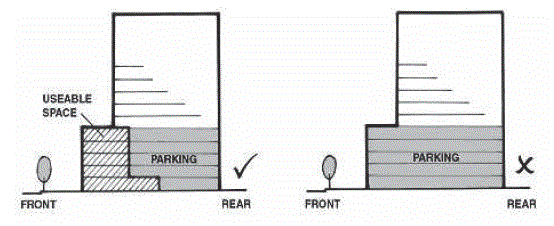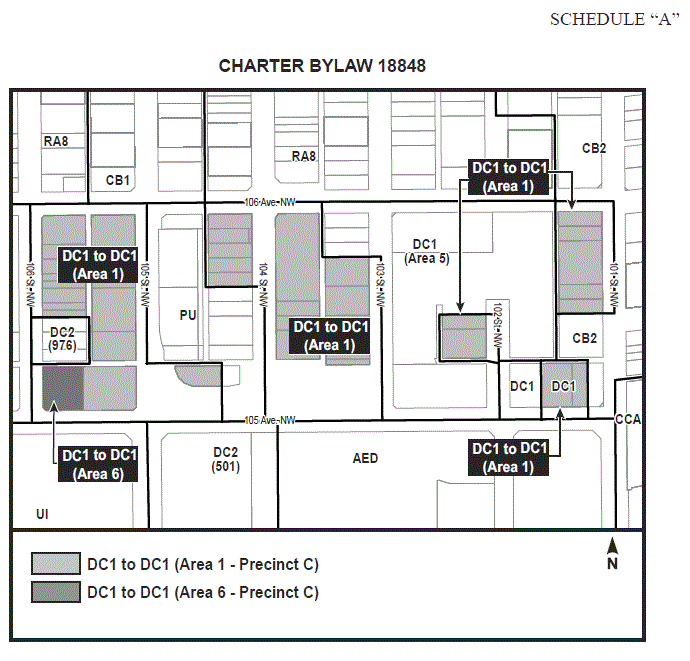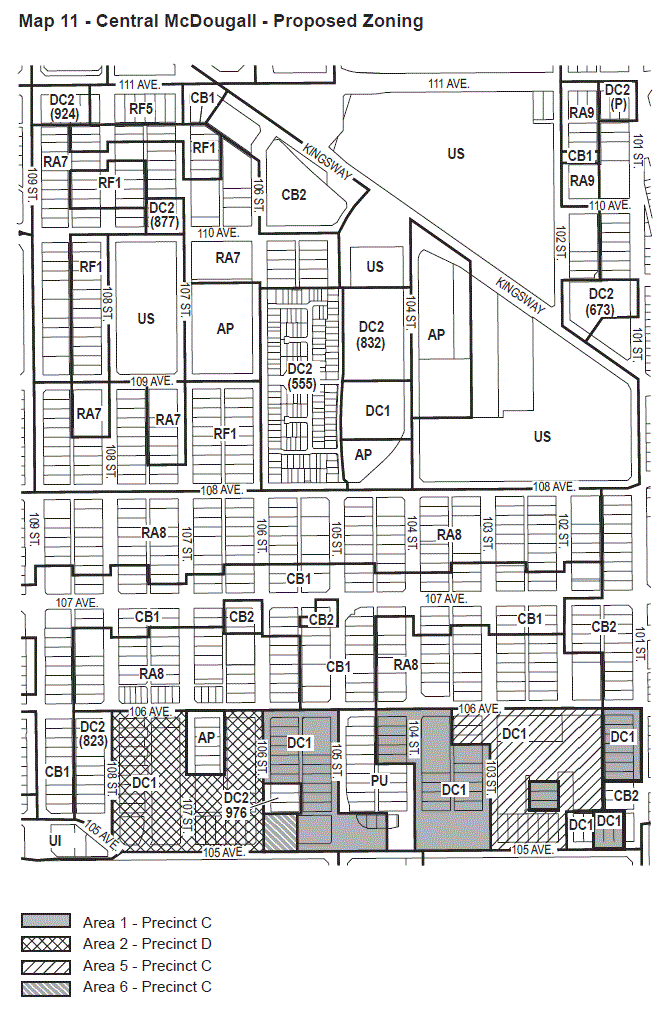
Bylaw 18847
May 13, 2019
To allow for the existing building on-site as of the date of this bylaw to be used for commercial purposes while ensuring future buildings accommodate a transit-oriented development/high density residential mixed use node that creates a liveable “urban village” environment and generates an improved sense of place and quality development through the use of urban design regulations and the introduction of high density apartment housing adjacent to the Downtown area and future high speed transit corridors. Minor local commercial uses will be encouraged, but not required.
This Provision shall apply to Lot 1, Block 5, Plan 9921814, located at 10505 – 106 Street NW; as shown on Schedule “A” of this Bylaw adopting this Provision, Central McDougall.
Apartment Housing
Bars and Neighbourhood Pubs
Breweries, Wineries and Distilleries
Business Support Services
Cannabis Retail Sales
Child Care Services
Convenience Retail Stores
General Retail Stores
Group Home
Health Services
Limited Group Home
Lodging Houses
Minor Alcohol Sales
Minor Home Based Business
Major Home Based Business
Professional, Financial, and Office Support Services
Residential Sales Centre
Restaurants
Specialty Food Services
Stacked Row Housing only when incorporated at the lower levels of a high rise building
Row Housing, only when incorporated at the lower levels of a high rise building
Veterinary Services
Fascia On-premises Signs
Freestanding On-premises Signs
Projecting On-premises Signs
Temporary On-premises Signs
The overall Site development shall be in accordance with the urban design criteria established herein and in the Central McDougall/Queen Mary Park Area Redevelopment Plan.
Prior to the issuance of any Development Permit, the owner shall provide proof satisfactory to the Development Officer in consultation with Alberta Environment and Sustainable Resource Development, Alberta Health Services, and Transportation Services that, if necessary, the lands have been remediated to allow the intended uses.
The maximum Floor Area Ratio of any development shall be 5.0, except that the maximum Floor Area Ratio shall be 6.0 for developments with larger individual unit floor plates.
The maximum Density shall be 500 Dwellings/ha.
The maximum Height shall be 45.0 m.
Building Setbacks shall be as follows:
0 m from Front Lot Line
0 m from Side Lot Line
2.0 m from Rear Lot Line
Landscaping shall be provided within the 2.0 m rear building Setback to provide an improved appearance of the Lane.
Apartment Housing with non-Residential and non-Residential Related Uses on the ground floor shall have access at ground level that is separate from the access for the non-Residential and non-Residential Related Uses.
Access to vehicular Parking Garages or parking areas shall only be from the Abutting Lane.
Loading, storage, and trash collection areas shall be located in such a manner to be screened from view from adjacent sites, public roadways, and Light Rail Transit lines. If the rear or sides of a Site are used for surface vehicular parking, it shall be screened from view.
Underground driveway ramps for Apartment Housing, Stacked Row Housing, and Row Housing developments must not exceed a slope of 6% and the ramp must be at Grade at the property line, to the satisfaction of the Development Officer in consultation with Subdivision and Development Coordination (Transportation).
No surface vehicular parking areas are permitted Abutting any public roadway, other than a Lane.
The owner shall submit a market value appraisal for the subject Site at the time of the submission of a Development Permit application for the purposes of determining the amount of the redevelopment levy that applies to the Site. The appraisal shall estimate the market value of the subject Site, based on the highest and best use of the land, as if vacant, and with the effective date of valuation being within 30 days of Development Permit application. The appraisal report must be reviewed and accepted by the Development Officer in consultation with Appraisal Section of the Asset Management and Public Works Department, and the Community Services Department. The redevelopment levy shall be 8% of the estimated market value of the Site, as if vacant, and shall be paid to the City of Edmonton as a condition of the approval of a Development Permit. All redevelopment levies collected will be used to fund the acquisition of public park space as identified in the Central McDougall/Queen Mary Park Area Redevelopment Plan.
The owner shall be responsible for the costs of the required streetscape improvements to the portion(s) of road right(s)- of-way Abutting a Site (from private property line to the new curb) that are identified by the 105 Avenue Corridor Study, and/or identified by the Development Officer in consultation with Community Services, City Planning, or Subdivision and Development Coordination (Transportation) as part of the development. These costs shall be paid to the City of Edmonton as a condition of the approval of a Development Permit. The required streetscaping improvements may include, but are not limited to, new sidewalks, streetlights, boulevard landscaping, boulevard trees, street furniture, and/or the relocation of utilities underground.
Where applicable, the Site plan submitted with a Development Permit application must indicate the coordination between development on the subject Site and the adjacent 105 Avenue corridor, in accordance with the 105 Avenue Corridor Study.
The owner shall be responsible for analyzing a portion of the sewer system affected by the development Site to determine sewer servicing and upgrading requirements to the satisfaction of the Development Officer in consultation with Drainage Services. Costs for relocating/abandoning sewer lines as a result of street/lane closures will be the responsibility of the owner. These costs shall be paid to the City of Edmonton as a condition of the approval of the Development Permit.
All mechanical equipment, including roof mechanical units, shall be concealed by screening in a manner compatible with the architectural character of the building or concealed by incorporating it within the building.
For new buildings, the owner shall submit a Crime Prevention through Environmental Design (CPTED) Assessment that shall be reviewed and accepted by the Development Officer prior to the issuance of a Development Permit to ensure that development on the Site provides a safe urban environment in accordance with the guidelines and principles established in the Design Guide for a Safer City.
Non-Residential and non-Residential Related Uses shall only be permitted when designed as an integral and secondary component of a residential development consisting of 50 Dwellings or more and shall only be developed within the lowest 4 Storeys of a building.
Signs shall comply with the regulations in Schedule 59B of the Zoning Bylaw.
Restaurants shall be limited to 100 occupants and 120m2 of Public Space.
Specialty Food Services shall be limited to 40 occupants and 48m2 of Public Space.
Where the ground (first) floor of any development is designed for non-Residential or non-Residential-Related Uses, the building shall be constructed to the Front property line. The Development Officer may allow a building Setback from the Front Lot Line of up to 2.5 m, to accommodate street related activities such as sidewalk cafés, colonnades, arcades, or plazas. The 2.5 m building Setback shall not be used primarily for Landscaping.
Where the ground (first) floor of any development is designed for Residential or Residential-Related Uses, the building shall be constructed to the Front Lot Line. The Development Officer may allow a building Setback from the Front property line of up to 4.5 m, only to provide physical separation from the Abutting street for the Dwelling units provided this Setback accommodates patios, courtyards, terraces, or other private amenity space directly associated with the Abutting Dwelling unit. The 4.5 m building Setback for Residential Uses shall not be used primarily for Landscaping.
There shall be a minimum of 3 and a maximum of 5 Storeys of a building immediately Abutting a public roadway, other than a Lane. Any portion of a building exceeding a Height of 5 Storeys or 17.5 m shall be stepped back a minimum of 4.5 m from the podium of the building adjacent to a public roadway, other than a Lane.
Explanatory Note 4.5 m stepback between the front of the building and upper building storeys is intended to reduce the perceived mass of a building and promote the pedestrian scale of the street. The following graphic representation provides a possible conceptual application of this regulation for interpretive purposes.

Buildings shall provide a minimum 7.5 m building Setback from the Rear property line above the podium level of the building.
Buildings shall provide a minimum 2.0 m building Setback from the Side property lines above the podium level of the building.
No portion of an above Grade Parking Garage on the ground (first) floor shall be allowed for a minimum depth of 10.0 m from any building Façade facing a public roadway, other than a Lane.
No portion of an above Grade Parking Garage above the ground (first) floor of the podium portion of a building shall be allowed for a minimum depth of 6.0 m from any building Façade facing a public roadway, other than a Lane. Explanatory Note - The following graphic representation provides a possible conceptual application of these regulations [(f) and (g)] for interpretive purposes.

Buildings shall address all adjacent public roadways, other than Lanes, with individual entrances that are clearly visible to lend a sense of occupancy to the street. Buildings on corner Sites shall address both the street and avenue and shall distinguish the street intersection to give it prominence.
Where a Dwelling unit is provided at ground level Abutting a public roadway, other than a Lane, the principal entrance to the unit shall have direct external access to the adjacent public sidewalk.
Where a non-Residential or non-Residential Related Use is provided at ground level Abutting a public roadway, other than a Lane,
the principal entrance to the unit shall have direct external access to the adjacent public sidewalk, and
a minimum of 50% of the ground (first) floor level portion of the Façade Abutting a public roadway, other than a Lane, shall be comprised of clear, non-reflective glazing to promote pedestrian interaction and safety.
At least 80% of the ground (first) floor shall be no higher than 1.0 m above the mean Grade of the adjacent public sidewalk at the property line.
Any building with a single wall length greater than 15.0 m Abutting or visible from a public roadway shall comply with the following:
the building Façade shall include design elements, materials, and articulation that reduce the perceived mass of the building Façade and add architectural interest.
Blank walls (with or without windows) of vehicular Parking Garages shall not be developed adjacent to, or visible from, any public roadway.
The finishing of the podium portion of any development shall consist of materials such as glass and glazed window wall systems, brick, stone, architectural concrete, and/or precast coloured concrete.
The use of stucco as a finishing material is not permitted on the podium portion of any development. The use of stucco on the tower portion of any development shall be limited to a maximum of 15% of the exterior surface area of the tower.
Development on a Site shall incorporate functional and decorative lighting to enhance the appearance of the building during the winter months, and, if applicable, to provide additional lighting for the 105 Avenue corridor.
Where non-Residential and non-Residential Related Uses are developed on the ground (first) floor of a building that is built to the Front property line, weather protection in the form of a canopy at least 2.0 m wide or any other method suitable to the architectural style of the building or street theme, shall be provided one Storey above sidewalk level to provide a comfortable environment for pedestrians.
The owner shall enter into an Encroachment Agreement with the City of Edmonton for the proposed canopies/overhangs, and any street related activities and public art that encroach on, over, or into road right-of-way.
Buildings shall be designed through their massing and location, to avoid adverse microclimatic effects such as wind tunnelling, snow drifting, rain sheeting, shadowing, and loss of sunlight, both on and off-site. The Development Officer may require the submission of a Wind Impact Statement or Study, and/or a Sun Shadow Impact Study to determine that proposed development achieves these objectives.
Main building entrances for any Use shall be designed for universal accessibility. Sidewalk furniture and other elements shall be located out of the travel path to ensure they are not obstacles to building access.
The upper two to four Storeys of high rise buildings shall step back from the lower levels of the tower portion of the building and provide distinctive shaping or sculpting of the roof line to contribute to a unique and interesting skyline.
Apartment Housing developments in this Precinct should incorporate 100 percent visitability and 10 percent adaptable suites to ensure universal accessibility.
The maximum Height opportunity presented in this Provision should be utilized to develop high rise buildings that reduce the impact of the upper levels of the building above the podium portion of the building to maintain view corridors of the Downtown, maximize solar penetration, and reduce adverse microclimatic effects related to wind and shadowing.
Where feasible, developments should provide gardens or patios on the top of the podium level and building rooftops to improve rooftop aesthetics and provide additional amenity space.
Development should utilize infrastructure practices and site designs that reduce the consumption of water, energy, and materials consistent with Leadership in Energy and Environmental Design (LEED) accreditation.
Landscaping of Sites should consider the use of plant materials that provide colour throughout the year to enhance their appearance during the winter months.
Notwithstanding Sections 4, 5, and 6 the development existing at the time of passage of this Bylaw shall be in accordance with the following regulations and in general accordance with Appendices I & II.
The existing building may not be enlarged, added to, rebuilt, or structurally altered except for routine maintenance of the building or to add an outdoor patio as described in Section 7(i) below.
There shall be a minimum of 18 on-site bicycle parking spaces.
There shall be a minimum of 18 on-site vehicular parking spaces
There shall be 1 on-site loading space.
Landscaping shall use plant materials that provide colour throughout the year to enhance their appearance during the winter months.
Development on a Site shall incorporate functional and decorative lighting to enhance the appearance of the building during the winter months, and, if applicable, to provide additional lighting for the 105 Avenue corridor.
Main building entrances for any Use shall be designed for universal accessibility through the use of a 2.0 m wide direct travel path, clear of any obstacles.
Any outdoor patio area shall be:
restricted to Bars and Neighbourhood Pubs, Breweries, Wineries and Distilleries, Restaurants, or Specialty Food Services located on the ground floor of the existing building;
designed to reflect the architectural character of the adjacent building and address the adjacent public roadways, particularly in terms of hard-surfacing materials, furniture style, quality of construction, materials and type of fencing selected for the area enclosure;
designed to have an open appearance with a defined edge, such as a railing, fence, or a row of planters or pots. The use of planters, flower boxes and landscaping elements shall be used to enhance the patio atmosphere as well as to define the patio boundary. Plastic plants and ornamental trees are not permitted.
Upon demolition of the building existing at the time of passage of this Bylaw, all new developments shall comply with the regulations stated in Sections 1 to 6.
If the building existing at the time of passage of this Bylaw is damaged or destroyed to more than 75% of the value of the building above its foundations, then the building may not be repaired or rebuilt unless it complies with the regulations stated in Sections 1 to 6.

